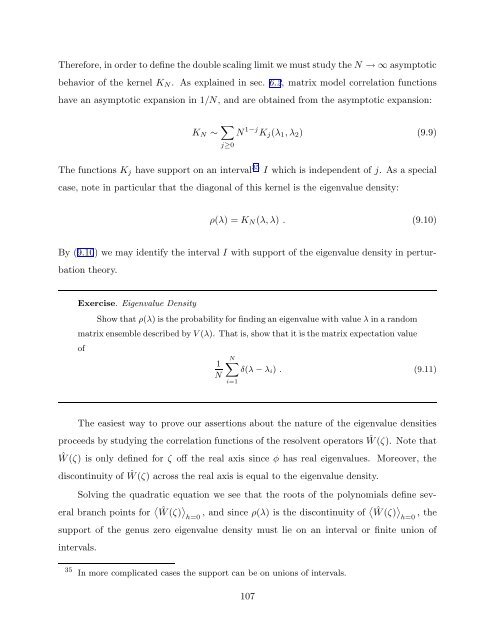arXiv:hep-th/9304011 v1 Apr 5 1993
arXiv:hep-th/9304011 v1 Apr 5 1993
arXiv:hep-th/9304011 v1 Apr 5 1993
You also want an ePaper? Increase the reach of your titles
YUMPU automatically turns print PDFs into web optimized ePapers that Google loves.
Therefore, in order to define <strong>th</strong>e double scaling limit we must study <strong>th</strong>e N → ∞ asymptotic<br />
behavior of <strong>th</strong>e kernel K N . As explained in sec. 6.2, matrix model correlation functions<br />
have an asymptotic expansion in 1/N, and are obtained from <strong>th</strong>e asymptotic expansion:<br />
K N ∼ ∑ j≥0<br />
N 1−j K j (λ 1 , λ 2 ) (9.9)<br />
The functions K j have support on an interval 35 I which is independent of j. As a special<br />
case, note in particular <strong>th</strong>at <strong>th</strong>e diagonal of <strong>th</strong>is kernel is <strong>th</strong>e eigenvalue density:<br />
ρ(λ) = K N (λ, λ) . (9.10)<br />
By (9.10) we may identify <strong>th</strong>e interval I wi<strong>th</strong> support of <strong>th</strong>e eigenvalue density in perturbation<br />
<strong>th</strong>eory.<br />
Exercise. Eigenvalue Density<br />
Show <strong>th</strong>at ρ(λ) is <strong>th</strong>e probability for finding an eigenvalue wi<strong>th</strong> value λ in a random<br />
matrix ensemble described by V (λ). That is, show <strong>th</strong>at it is <strong>th</strong>e matrix expectation value<br />
of<br />
1<br />
N<br />
N∑<br />
δ(λ − λ i ) . (9.11)<br />
i=1<br />
The easiest way to prove our assertions about <strong>th</strong>e nature of <strong>th</strong>e eigenvalue densities<br />
proceeds by studying <strong>th</strong>e correlation functions of <strong>th</strong>e resolvent operators Ŵ (ζ). Note <strong>th</strong>at<br />
Ŵ (ζ) is only defined for ζ off <strong>th</strong>e real axis since φ has real eigenvalues. Moreover, <strong>th</strong>e<br />
discontinuity of Ŵ (ζ) across <strong>th</strong>e real axis is equal to <strong>th</strong>e eigenvalue density.<br />
Solving <strong>th</strong>e quadratic equation we see <strong>th</strong>at <strong>th</strong>e roots of <strong>th</strong>e polynomials define several<br />
branch points for 〈 Ŵ (ζ) 〉 , and since ρ(λ) is <strong>th</strong>e discontinuity of 〈 Ŵ (ζ) 〉 , <strong>th</strong>e<br />
h=0 h=0<br />
support of <strong>th</strong>e genus zero eigenvalue density must lie on an interval or finite union of<br />
intervals.<br />
35 In more complicated cases <strong>th</strong>e support can be on unions of intervals.<br />
107
















